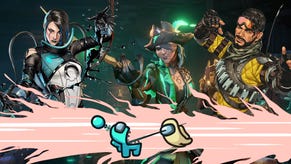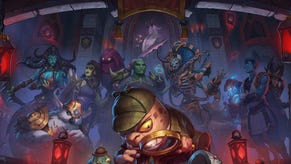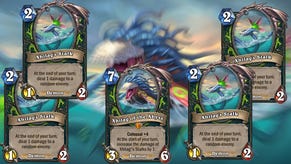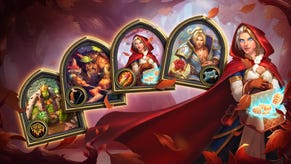Wot I Think: Hearthstone's Blackrock Mountain
I'm a card-carrying seismograph
Weelcome, it's goood ta see ya again! Blizzard may not do the best Scottish accents in the world (and have you heard that Brit in Overwatch?) but there's no doubt they make extremely sticky games – I must've been welcomed to the inn thousands of times by our dwarven chum. Part of this longevity is the sheer quality of the core games, and the other is in how well and regularly Blizzard maintains and expands things. The latest expansion for Hearthstone [official site], Blackrock Mountain, is a singleplayer adventure costing a whopping £17.50 – read on to see wot I think.
The Goblins 'n Gnomes expansion in late 2014 added a tonne of cards to Hearthstone and while Blackrock comes with some new toys, it doesn't add to the game with anything like that scale. We can now see a pattern in the game's releases: first was Curse of Naxxramas, a singleplayer adventure, then Goblins 'n Gnomes, a cardfest, and now Blackrock, a singleplayer adventure, with four or five months between each. So first of all, expect some new cards in the Autumn, and secondly admire the efficiency with which Blizzard approaches this work. A card game's lifeblood is new cards and so this model allows Hearthstone to have one big injection per year, alongside a minor fillip dressed up as singleplayer.
That last bit was too harsh, perhaps? There is of course value in a decent singleplayer mode, but for Hearthstone – a game played entirely against other people – it's more a matter of convenience than an overarching necessity. That's not to say Blizzard phones these adventures in, and Blackrock Mountain has charms, it's just the way it is – personally, I get the Adventures to play through them and acquire the new cards as fast as possible.
The cost is an interesting one. Initially it took me aback, but that was entitlement speaking – I play Hearthstone fairly regularly and have done so since release, for free. Sure I've bought some cards after a nice payday, but the pressure to spend in Hearthstone is so light it's almost not there at all. The other side is that you can pay for each of Blackrock's five wings with 700 Gold and get a proportional discount. I'm not an enormous fan of the 'you don't have to pay, you can grind!' rationale as a rule but, again, Hearthstone being such good value-for-no-money makes it hard to grumble.
The wing structure, with one released per week from launch, does bother me though. As of this writing four of five have been released and the structure seems little more than a way to stretch time and make the expansion feel larger than it is. You'll breeze through each wing's normal mode – three fights – in twenty minutes, unlocking the Class and Heroic challenges, the former being another fifteen-minute cakewalk and the latter a curious 'endgame' we'll come to later. The wings serve no purpose other than making sure you can't bash through Blackrock in an hour or so and scoot off with your cards, and it's hard to feel good about that.
Driving through each wing, however, is a lot of fun. The three fights are each introduced by a hammy villain, who initially pretends to be your buddy in the most OTT glowing-eyes-and-goatee way, and the bosses have a unique hero power and a deck that works with it – one might summon a minion from both decks every turn, while another grows eggs that explode for mega damage, and some reverse expectations by having conditions for use that you then have to ensure are not met. Any reasonable Hearthstone deck won't have much trouble with them, but the reward of a free card after every victory somehow makes things very satisfying anyway.
The Class challenges are even easier, despite the title, setting you against the bosses with a premade deck that's always more than up to the task, but fun to use. These challenges each reward a card too, so ticking them off is another enjoyable moment for the loot hoarder in all of us.
So far so good, but I find myself really wondering about the function and design of the Heroic challenges in Blackrock. These encounters are supposed to be super-difficult and, as the game says, require multiple attempts and deck revisions to beat. The first challenge, against Coren Direbrew, shows what's to come by amping up his hero power – every turn he now summons two minions from his power-packed deck, but only one from yours – and,as if this wasn't enough, gives him a larger-than-normal deck size. Note that Hearthstone's designers are now breaking fundamental rules in order to introduce artificial difficulty, but let's run with it.
The main problem with designing a super-specific and tough challenge in Hearthstone is that the game itself doesn't support this style of play. At the core of Hearthstone is the random chance of a given deck, yet here we are faced with an inflexible set of demands – yes there are counters to each Heroic boss strategy, but whether you can perform them depends on the luck of the draw.
So take for example Emperor Thaurissan, whose heroic ability is 'deal 30 damage' (i.e. instakill you). But this can't be used unless his wife (a 3/1 minion) is dead. In the Heroic Challenge you need to neuter his wife without killing her (or she'll kill you), but Thaurissan's deck is full of cards that will deal damage to all minions like Death's Bite and Abomination. Yes, he's going to kill his own wife.
Thus your deck has to include ways to silence his spouse-shattering minions and, because weapons like Death's Bite can't be silenced, ways to protect her from other damage too. So I built a Paladin deck to give her divine shields, chucked in a load of silence and 0 attack taunt, and had other neat ideas like giving his wife a Blessing of Wisdom (I draw every time she attacks).
This deck hard-counters what Thaurrisan is doing but its utility depends on getting the cards in a an extremely specific order. If I didn't get an excellent mulligan I immediately conceded and started again. Sometimes I'd concede after two turns, or three. If you don't have a silence or divine shield when he whacks down Abomination or Death's Bite on turn four, it's a GG. And he'll have multiples so you'll need multiples.
I enjoy having to work out a puzzle, looking at how a particular boss operates and then 'solving' it with a new deck. But these encounters have such strict win/lose conditions that the fun is lost because every strategy relies so utterly on randomness to work – you must draw the right cards in the right order. It counter-intuitively removes the flexibility and surprise that are the good elements of random design, and foregrounds the punitive and frustrating parts no-one likes. You're not even learning anything new about how the game works, which should be the prime target for any Hearthstone singleplayer design. When Thaurissan fell it didn't feel great, I just felt glad my luck had held and that it was over.
The final insult? I didn't even get a new card! Joking aside, Blackrock introduces 31 new cards with the minor theme being Dragons, a faction that has existed in Hearthstone since the beginning but hasn't thus far been developed. Blackrock's Dragon cards basically offer bonuses for having other Dragon cards, which didn't exist previously, and so tie them together much more neatly as a set – a Paladin for example could build a neat deck around using the new Dragon Consort, a 5-mana 5/5 that reduces the cost of the next Dragon by 2 mana, and getting out the legendary 8-mana card Chromaggus on turn six. A sprinkling of minor Dragon minions takes care of the opening and thus another style of minion deck is born.
Other class-specific cards tidy up holes in their armour or offer neat new possibilities. Shaman can now unlock overloaded mana crystals (the main disadvantage of that hero's cards) by ending their turn with the 2-mana Lava Shock that as a bonus deals 2 damage. Warlocks gain Demonwrath, a 3-mana early board clearer to help those disgusting rush decks, and another imp-summong minion, while Warrior gets the amazing 4-mana Axe Flinger, a 2/5 that does 2 damage to the enemy hero every time it takes damage. Druid, Mage, Priest, and Hunter get nice but familiar new toys, while Rogue gets what seems to be the most OP card in the world – Gang Up. This beauty puts three copies of any minion on the board in your deck. Get this in the lategame and some ridiculous stuff can happen – I haven't managed it yet, despite my best efforts, but soon I will clone, assassinate, and then slam down three Yseras.
So Blackrock adds up to a decent expansion for the money, adding a little freshness to core play with the Dragons and new class cards, and giving every player a diverting few hours worth of adventure. Despite any issues, it is all-too-easy to underestimate the skill with which Blizzard's designers are pulling this off – adding to a core game would be easy if you just repeat and tweak the existing cards, but each expansion always adds a few new notes to Hearthstone's already-rich interplay. We may have to wait for the revolution, but Blackrock Mountain is business as usual for Hearthstone. And business is good.






















